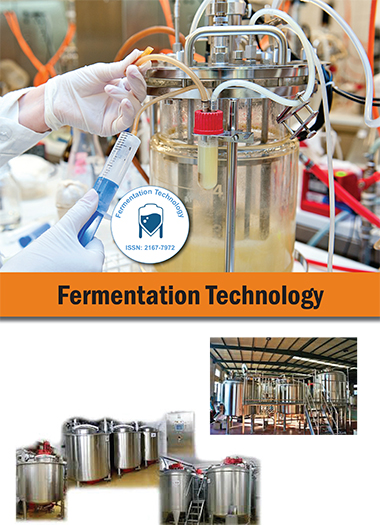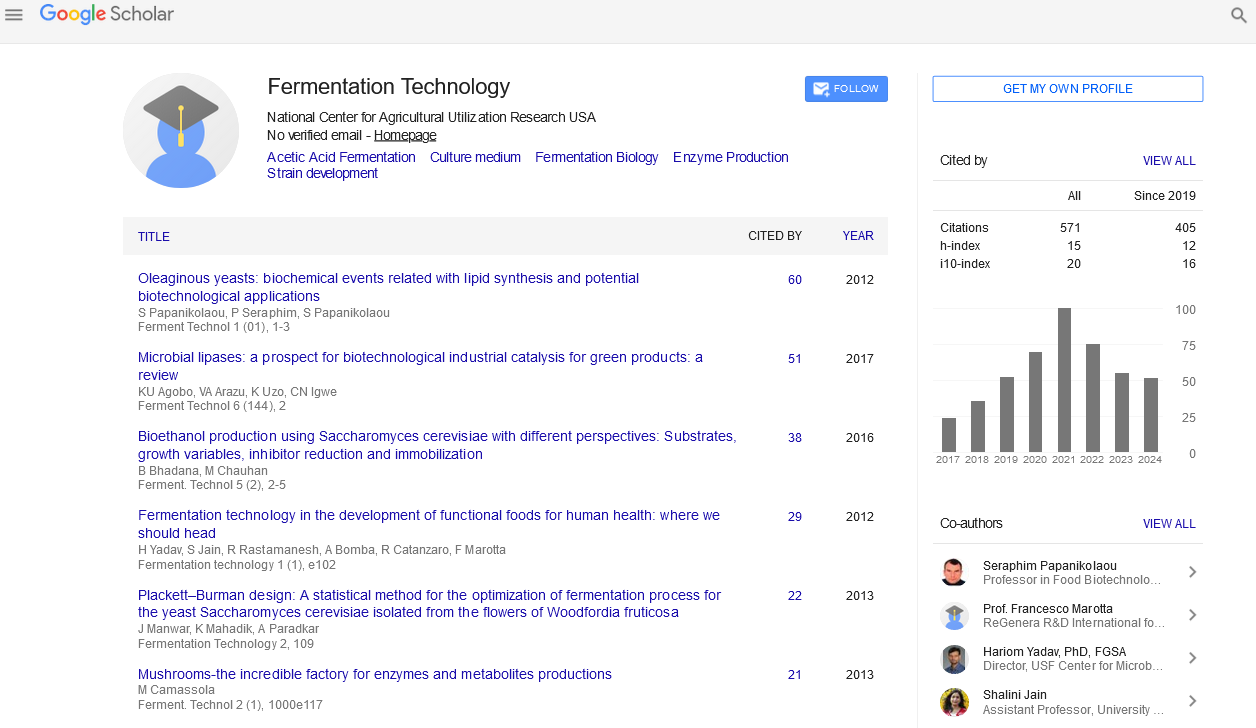Indexed In
- Open J Gate
- Genamics JournalSeek
- Access to Global Online Research in Agriculture (AGORA)
- RefSeek
- Hamdard University
- EBSCO A-Z
- OCLC- WorldCat
- Publons
Useful Links
Share This Page
Journal Flyer

Open Access Journals
- Agri and Aquaculture
- Biochemistry
- Bioinformatics & Systems Biology
- Business & Management
- Chemistry
- Clinical Sciences
- Engineering
- Food & Nutrition
- General Science
- Genetics & Molecular Biology
- Immunology & Microbiology
- Medical Sciences
- Neuroscience & Psychology
- Nursing & Health Care
- Pharmaceutical Sciences
Commentary - (2025) Volume 14, Issue 1
Optimization of Solid-State Fermentation for High-Yield Enzyme Production Using Agro-Waste Substrates
Nelson Samuel*Received: 26-Feb-2025, Manuscript No. FMT-25-29068; Editor assigned: 28-Feb-2025, Pre QC No. FMT-25-29068 (PQ); Reviewed: 13-Mar-2025, QC No. FMT-25-29068; Revised: 20-Mar-2025, Manuscript No. FMT-25-29068 (R); Published: 27-Mar-2025, DOI: 10.35248/2167-7972.25.14.178
Description
Solid-State Fermentation (SSF) is a microbial process where growth occurs on moist solid materials without free-flowing water. This technique has been traditionally employed in the preparation of fermented foods, but recent industrial interest focuses on its use for enzyme production. SSF presents several advantages over Submerged Fermentation (SmF), including reduced energy requirements, higher product concentration and the ability to utilize low-cost agricultural by-products.
Substrate selection and preparation
The choice of substrate is fundamental in SSF systems. Agricultural residues such as wheat bran, rice husk, sugarcane bagasse, corn cob and soybean meal are widely used due to their nutrient content and structural properties. These materials serve both as physical support and carbon/nitrogen sources for microbial growth.
Before use, substrates often undergo size reduction, soaking and sterilization to improve moisture retention and reduce microbial contamination. Supplementing substrates with additional nitrogen or trace minerals may enhance enzyme synthesis.
Microbial strain selection
A diverse group of microorganisms, particularly filamentous fungi such as Aspergillus niger, Trichoderma reesei and Penicillium spp., are known for their ability to produce industrially relevant enzymes under SSF conditions. Bacterial strains such as Bacillus subtilis are also utilized in certain systems.
Strain screening is typically done using plate assays for initial enzyme activity, followed by flask-scale trials. Genetic modification and adaptive evolution techniques are now being applied to improve strain performance under SSF conditions.
Moisture content and water activity
Maintaining appropriate moisture levels is essential for microbial metabolism in SSF. Too little moisture limits microbial growth and enzyme secretion, while excess water can reduce substrate porosity and lead to anaerobic zones. Optimal moisture content generally ranges from 50%-70%, depending on the substrate and organism. Techniques such as pre-wetting, misting and humidity control are employed to manage moisture throughout fermentation.
Aeration and temperature control
Proper aeration is necessary to maintain aerobic conditions and to remove metabolic heat. The compact nature of SSF beds can limit oxygen diffusion, particularly in large-scale systems. To address this, tray fermenters and packed-bed bioreactors are used to increase surface area and airflow.
Temperature must be carefully monitored, as SSF systems tend to accumulate heat due to metabolic activity. Most SSF systems operate effectively between 25°C and 35°C. Thermotolerant strains and heat-resistant enzymes provide additional advantages in such conditions.
pH and inoculum optimization
Initial substrate pH influences microbial growth and enzyme secretion. While most fungi prefer slightly acidic conditions (pH 5.0-6.0), bacterial systems may function better under neutral pH. The size and form of the microbial inoculum also affect fermentation efficiency. Inoculating with actively growing spores or vegetative cells ensures faster colonization of the substrate and reduces the risk of contamination.
Enzyme extraction and activity assessment
Enzyme recovery from solid substrates is typically achieved by extracting with buffer solutions followed by centrifugation. Variables such as extraction time, buffer composition and agitation affect recovery efficiency.
Quantification of enzyme activity is carried out using specific substrates under defined assay conditions. Parameters such as unit activity per gram of dry substrate (U/gds) are commonly reported.
Scale-up and bioreactor design
Scaling up SSF presents challenges due to heat buildup and inconsistent aeration. Conventional fermenters are unsuitable and specialized designs such as rotating drum bioreactors, static tray systems and fluidized beds are developed for SSF. Automated control systems are now being incorporated for monitoring temperature, humidity and airflow. Mathematical modeling and computational simulations support process prediction and design optimization at larger scales.
Applications and market potential
Enzymes produced through SSF have applications in diverse industries. Cellulases and xylanases are used in biofuel production, proteases in detergents and food processing and amylases in textile and baking industries.
The economic benefit of using agro-waste as substrate significantly lowers production costs and supports environmentally conscious manufacturing. Many small and medium-scale industries, especially in resource-limited settings, are adopting SSF as a viable production platform.
Conclusion
Solid-state fermentation offers an effective and sustainable approach for enzyme production using agro-waste materials. Optimization of key parameters including substrate composition, microbial selection and process control can significantly enhance yield and process consistency. As interest grows in low-cost and eco-friendly technologies, SSF is likely to play an increasingly important role in industrial biotechnology.
Citation: Samuel N (2025). Optimization of Solid-State Fermentation for High-Yield Enzyme Production Using Agro-Waste Substrates. Ferment Technol. 14:178.
Copyright: © 2025 Samuel N. This is an open-access article distributed under the terms of the Creative Commons Attribution License, which permits unrestricted use, distribution and reproduction in any medium, provided the original author and source are credited.

